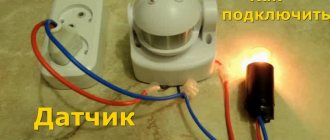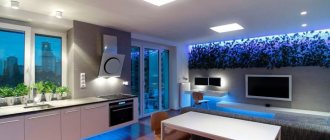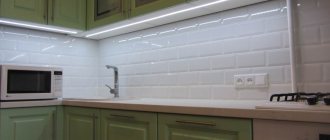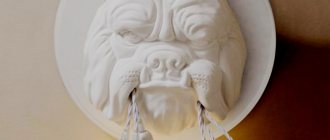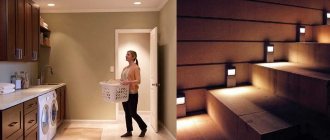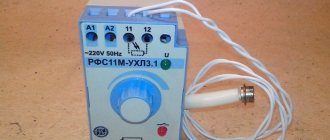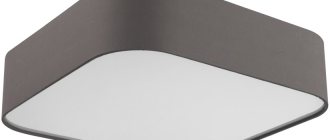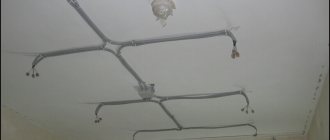Recommendations for organizing lighting
When choosing the type of backlight, several features are taken into account:
- First of all, you should pay attention to the length of the descent. The longer the flight of stairs, the more light is required.
- The devices should emit a calm light that will not dazzle a person or irritate the eyes.
- Energy consumption should be economical since the backlight requires frequent use.
- You need to take care of safety and install an autonomous type of lighting that will operate using a battery or accumulator in the event of a power outage.
- The light flux should not create shadows or distort the configuration of the steps.
No. 2. Types of stairs in a private house
Staircases can be classified according to material, layout, purpose and other parameters, but the most important is the division by type of construction . There are the following main types of stairs:
- marching;
- screw, or spiral;
- stairs on rails.
The choice of type of construction depends on your own preferences, the style of the house, as well as the space that can be allocated for the stairs.
What kind of lighting can I use?
The main lighting options are highlighted.
Automatic backlight
Thanks to this option, the operation of light sources is greatly simplified. Smart lighting with motion, load or switching sensors due to voice command and clap, can have one mode with the same intensity or smoothly operate on a timer with a certain time delay.
In the dark, the sensors react automatically and each step is illuminated sequentially. By setting up the control controller, you can set any parameters, for example, set the glow to the desired brightness level, and also select the speed at which the backlight will light up and fade out. Night lighting of the stairs should not be very dynamic.
The photo shows automatic lighting of the staircase in the interior of a private house in a modern style.
Wireless lighting system
A profitable option that operates on autonomous power. Such a system includes motion sensors and lamps tuned to the desired frequency. The operation of the composite modules is carried out using conventional batteries.
The photo shows a flight of stairs with railings equipped with wireless lighting.
Standard Wired System
Installing a traditional wired system requires some skill, so it's best to seek professional help.
First of all, a competent wiring diagram is required, then all the elements of the circuit are purchased and the surfaces are prepared to lay the cable. An ordinary concrete surface can be grooved, and in timber or log houses the wires are laid in cable channels and special corrugated tubes.
Life hacks and tips
instagram @juli_pisareva
- It is better to think through all lighting scenarios at the construction and renovation stage. Lay the wiring, make conclusions for all lamps, for built-in ones - prepare recesses. This will avoid additional “dirty” work.
- If several light scenarios are used, it is better to choose bulbs of different brightnesses for different lamps. So, the brightest should be ceiling lights or chandeliers.
- Use an automatic on and off system not only for the LED strip, but also for other lamps. You can use built-in sensors: motion sensors, sound sensors and others.
- If there is no desire or opportunity to automate the lighting, install pass-through switches. With their help, it will be possible to turn the lighting on and off both on the upper platform and at the bottom of the structure.
- Take a closer look at wireless lighting. It is convenient to install. The lamps operate from autonomous power sources.
- If the staircase is narrow and dark, mirrors will help expand the space and add light. Position them so that the lamps are reflected in them.
Options for lighting fixtures for stairs
Popular types of lighting fixtures.
Spot lighting for stairs
The devices are mainly built into the wall, near which there is a passage to the second floor. The installation of such light bulbs is planned even before finishing the wall surface.
Spot lighting of steps or risers is considered convenient. To install floor lighting, purchase spotlights and attach them to the surface of the steps using self-tapping screws or a self-adhesive base. The main advantage of this type of lamps is the ability to change the direction of the light flow.
The photo shows a staircase in a private house, decorated with wall spotlights.
LED Strip Light
It features an adhesive base, which significantly speeds up and facilitates the installation process. LED strip can have a variety of colors. The most common is white light of a warm or cool shade.
Due to the flexibility and free variation of the length of the LED strip, there is wide scope for the implementation of original ideas. This type of lighting is installed under steps, under stair railings, or built into a box on the wall.
The photo shows blue LED lighting for a staircase in the interior of a country house.
Chandelier over the stairs
The lamp, harmoniously combined with all interior details and wall cladding, will favorably emphasize the surrounding design.
When using this type of lighting, the cable for connecting the lamp is hidden in the ceiling. A hanging chandelier can create high-quality lighting even for a two-flight flight of stairs. Very often, in spacious houses, a cascading chandelier is installed. Bulbs suspended at different levels provide even light for the entire lifting structure.
The photo shows a country house with a luxurious chandelier located above the stairs.
Wall sconces
Staircase lighting in the form of wall sconces illuminates a fairly large area. If it is not possible to groove the walls for wires, the plane is equipped with a cable channel.
Sconces can be combined into one electrical chain and a common switch can be installed. If a motion sensor is connected, it will be possible to automatically turn on the wall lamps.
The photo shows the interior of the hall with a staircase complemented by wall sconces.
Combined lighting
The use of several light sources is an excellent option for a flight of stairs to the second floor. For example, to organize only the illumination of steps, they can be equipped with spotlights or linear lamps. Sconces are used to illuminate the entire space. Lighting devices can be switched on either together or separately.
The photo shows the lighting of the staircase with a ceiling chandelier and wall spotlights.
Automatic backlight
Its installation will save you from having to manually turn on the light. To turn the backlight on automatically, you can set:
- Motion Sensor;
- timer;
- sound device;
- load sensor
The first one will be triggered when someone approaches the stairs. The timer can be set for the period of time during which you are at home. But this is not always convenient. If you install a sound sensor, the light will light up when you clap your hands or when talking. The load sensor is triggered when you place your feet on a step or touch the railing.
When choosing a backlight, remember that any automation can malfunction and one day not work. In this case, you should know how to turn off all sensors and where the regular switch is located in the house.
Which lighting arrangement is best?
Examples of placement of light sources.
Staircase lighting on steps
The lighting of the steps is selected to match the style of the staircase and the interior design of the cottage. For such lighting, it is better to prefer devices that have a soft glow that will not strain the eyes and form bright shadows.
To install lighting, holes are made in the steps and wiring is routed out. Light bulbs are placed in different ways in each stage or through one.
The photo shows a flight of stairs with LED illumination of the steps.
Lighting with wall lights
It is advisable to place the sources at the level of a standard human height and not too far from each other. This way you can achieve even lighting on the stairs and avoid darkening the steps.
In color and design, lighting fixtures should be in harmony with the style of the staircase and the overall interior of the house.
The photo shows a wall with spotlights in the design of the staircase.
Ceiling lighting
Top lighting is considered if the ceiling plane is at least 3 meters high, since such an arrangement of lamps visually conceals the area.
For the ceiling, it is better to choose lamps that have several spotlights with a diffuse, versatile light flux. Devices that create reflected or downward light will fit well into the staircase space.
Decorative lighting for railings
Thanks to the illumination of the railing, it will be possible to give the fence a shine and visually make it lighter. For decoration, they prefer LED strip, which adds exquisite charm and even some mystery to the staircase.
Methods of lighting stairs
The staircase to the second floor becomes an important element of the interior of the entire house (even the semantic center). Therefore, its lighting should be thought out as much as possible. With the help of light, you can highlight zones and emphasize them.
During preparatory repair work, immediately determine how the lighting will turn on: automatically or manually. If you choose the first option, you will need to install motion sensors. If the second one suits you, then you will need to install switches in several places.
Choosing lighting for the type of staircase
Depending on the material and design features, spans are divided into several types.
| Type | Better lighting | Photo |
| Spiral staircase | For a flight with steps that have a spiral arrangement, ceiling lights or devices mounted to a central post are suitable. | |
| Marching staircase | Such staircase structures are considered the most comfortable and convenient for installing any type of lighting. | |
| Material of steps and stairs | ||
| Wooden staircase | Wooden construction is highly flammable, so it is important that the electrical wiring is insulated. The span should be supplemented with low-current systems and lamps with bulbs that do not heat up. | |
| Metal staircase | Since this material conducts electricity well, all cabling is equipped with flexible insulation. This staircase looks original in the design of outdoor lamps in the form of a chandelier or sconce. When choosing lighting for a combined structure with plastic elements, you also need to take into account their flammability. | |
| Staircase with transparent steps | Acrylic or glass are used to make transparent steps. As a backlight, the end side of the steps is equipped with a screen that allows you to achieve a glowing effect. | |
| Concrete staircase | The best option for a concrete flight of stairs is side lighting installed fifty centimeters above the plane of the steps. If the structure is of sufficient height, a ceiling chandelier is installed. | |
Types of lighting devices used
For each case, the type of lighting device is selected individually, based on the parameters of the staircase. Therefore, before purchasing specific equipment, study the features of the most popular options.
LED strips and tubes
LED strips and tubes
LED strips perfectly bend around any surface and adapt to the shape and length of the stairs. But direct installation of the tape, as a rule, is not performed, since open light elements dazzle the eyes. Therefore, the tape is placed in a tube that diffuses the light flux.
Spotlights
Spotlights Spotlights
provide good lighting brightness, but each such lamp is designed for a certain power. If the design parameters are exceeded, they can overheat and quickly fail. For the most part, they provide a directional flow even with frosted glass and a diffuser, which must be taken into account when installing them.
Wall sconces
Wall sconces for lighting stairs
Decorative sconces are a wall chandelier that is placed at eye level. When choosing a specific model, it is desirable that it be consistent in style and shape with existing chandeliers on the ceiling or other lamps in the house near the stairs. There are quite a few options for how to attach the lampshade, so you can choose one located near the wall or one located near the stairs.
Staircase or ceiling chandeliers
Ceiling chandeliers for lighting stairs
Some models of stairs allow you to use a ceiling chandelier with a classic arrangement of lamps or non-standard elongated models for their lighting. For houses with a high ceiling, it is rational to use a chandelier on a bracket or mounting cord. If there is a large distance from the lighting fixture to the steps, the lampshades should redistribute the flow in the desired direction. Glossy walls and transparent or free space under the railings help ensure uniform lighting along the entire perimeter of the staircase.
Features of choosing lamps for illumination
Lamps have their own characteristics and characteristics. The use of neon, halogen and LED bulbs is a traditional solution.
Neon products have a soft, diffused glow that fits perfectly into the limited staircase space. This type of lamp is durable, but at the same time sensitive to mechanical stress. Therefore, a reliable protective housing should be provided for them.
Halogen has a brighter luminous flux, which leads to strong heating. Therefore, these models are not recommended for use on wooden marches.
LED lamps are characterized by different shapes, colors and power levels. LEDs provide economical energy consumption, have a long service life and do not heat up.
Selecting the type of light bulbs
Incandescent lamps are practically not used for illumination and illumination due to low efficiency and high heating temperature.
Therefore, it is more advisable to install on stairs:
- LED lamps are the most favorable in terms of the ratio of light emitted per watt consumed; connecting LED lamps is suitable in almost any case, which makes them a universal option;
- fluorescent - inferior in efficiency and service life to LEDs, they also contain toxic mercury;
- halogen - one of the cheapest, but provides poor lighting performance and has a short service life;
- neon - do not give a lot of light, but have a wide range of colors, for which they are often used in backlights.
How to make step lighting with your own hands?
The stage lighting device requires two power supplies. The first is used to maintain the correct voltage balance, and the second is used to integrate the circuit into a household network.
Step-by-step instruction
In the attached instructions, all stages of connecting the staircase lighting are described sequentially. Therefore, any beginner can handle the installation.
For self-assembly, you will need to use tools in the form of a tape profile, self-tapping screws and a screwdriver. If there are protrusions at the steps, the LED tube is attached using an adhesive backing. Otherwise, you will need to use an installation profile.
- Cut the tape to the desired width.
- Mount the profile on the steps using 4 self-tapping screws.
- Attach the open LED strip to the profile.
- Close the tape with a special insert, which acts as a protection and anti-slip element.
- Conceal the wires under the baseboard or steps.
- Connect the power supply, stabilizing and control device.
- Close the circuit to the switch.
Video tutorial
A visual example of the installation of staircase lighting.
No. 1. The main components of the ladder and requirements for them
The staircase design includes the following elements:
- Steps are an essential part of any staircase. They consist of a tread , a horizontal surface, and a riser , a vertical part that serves as additional support. Some types of stairs may not have risers. The width of the tread is selected taking into account the convenience of placing the foot on it (the optimal value is 30 cm), the length can range from 90 to 150 cm and depends on many factors. The height of the riser is usually 15-20 cm. The width of the tread in spiral staircases at the two ends is different, it is important that in the central part this parameter is at least 25 cm;
- support beams - elements used to fasten steps. For marching stairs, a stringer and a bowstring are used. The stringer is a monolithic beam that supports the steps from below, the bowstring is the end beam. For spiral staircases, the supporting element is a pillar to which all steps are attached;
- railing ensure safety of movement on stairs and consist of balusters and handrails. Balusters serve as supports, fencing and decoration.
Beautiful design ideas
The multi-colored LED lighting of the staircase will give a new look to the surrounding space. This design technique will create a unique and inimitable atmosphere in the interior of the house.
The photo shows the design of a staircase with multi-colored lighting in the interior of the house.
An unusual solution is to decorate the steps of the stairs with garland, lanterns or candles, which can be lit only when necessary.
No. 4. Stairs on rails
Sometimes staircases on rails are classified as one of the design options for a flight of stairs, but the originality of the solution forces them to be distinguished as a separate type. The main feature of the design becomes clear if we translate the word “bolz” from German: it means “bolt”, “pin”. The steps of such a staircase are attached to the wall with invisible fasteners, bolts or heavy-duty bolts . Outwardly, it looks as if the steps are floating in the air, which allows you to create durable, but not very massive structures.
The bolt ladder can withstand weight up to 1500 kg, so external fragility is deceptive. Such structures are compact, but require a strong load-bearing wall , because the main load is placed on it. The use of handrails in this case is mandatory.
No. 5. Spiral staircases: features and advantages
Spiral or spiral staircases look impressive and immediately attract the eye. Such structures are a “ribbon” of steps twisted around a support pillar . Spiral staircases provide room for design imagination, because you can arrange it in a traditional round shape, or you can, for example, make it in the shape of an octagon.
Despite the fact that spiral staircases look very impressive, in terms of comfort of movement they are much inferior to marching ones and are installed only if it is necessary to strictly save space. Often such structures lead to the attic or attic floor.
The support of a spiral staircase is usually made of metal (sometimes wood), but the steps can be glass, wood or stone. The narrow part of the steps is mounted to the post, and the wide part is attached to the balusters, wall or railing post. As a rule, spiral stairs are made without risers. The width of the tread in the center of the step should be 20-25 cm, in the widest part - 40 cm.
Option 1 – Pass-through switches
We have already discussed with you the connection diagram for a pass-through switch. There is nothing complicated, but with the help of such devices you can control the light from 2, 3, or even 4 points. This idea is often used in private homes. If the length of the steps is small, one switch should be mounted on the first floor, the second one on the second floor. The staircase lighting diagram will look like this:
If you need to control the light bulb from three places, you can install an auxiliary switch - cross. In this case, the lighting scheme for a landing in a private house will look like this:
As you can see, wiring is not complicated. The zero is connected directly to the lamp, the phase is connected to the break.
No. 9. Design styles for staircases in the house
Like interiors and landscapes, stairs can be designed in different styles. Of course, the chosen style must correspond to the overall interior design of the house. Designers identify a lot of stylistic trends, of which the main and most common are the following:
- classic style is natural, discreet shades, natural materials (stone and wood), carvings, curls, decorative balusters;
- a neutral style is used in arranging a staircase when it is not intended to play the main or one of the main roles in the interior. In this case, it is assumed that the staircase is a functional and as discreet detail as possible; there are no strict requirements for its design;
- modern style , which includes such trends as minimalism, hi-tech, modern and art deco, involves the use of glass, metal and an abundance of lighting elements;
- Country is the ideal style for a country or village home. A country-style staircase is made of wood, made deliberately rough, and can be covered with a carpet or carpet overlays on the steps.
No. 7. Installation location and optimal dimensions of the stairs
When choosing a staircase design, first of all, the parameters of the room are taken into account. It is important to correctly assess the area that is allocated for organizing the staircase: if it is 3 m2 or more , you can make a flight of stairs or a staircase on rails; if it is less, then your option is a spiral staircase.
The width of the spiral staircase should be at least 100 cm, it can be more, but then the space occupied by the structure will increase. The optimal width of the main and main stairs is 120-150 cm. In this case, the comfort of movement of two people at the same time is ensured. As for the handrails , their height should be about 80 cm. If there are children in the house, then the distance between the balusters or posts should not be less than 15 cm.
Stair width
The most important parameter of the staircase is its angle of inclination (relevant for marching and bolt structures). It’s great if you can achieve an angle of 45 degrees - this is the optimal value. The greater the deviation from this number, the less convenient it is to walk on such stairs. The parameters of the width of the tread and the height of the riser depend on the angle of inclination: the greater the angle, the smaller the tread and the higher the riser will be.
Installation options and preparatory work
Everything written above can be summed up: usually lighting fixtures are located on the side wall or built into steps (railings). The installation of LED devices will be discussed below.
Required materials and tools
To complete the lighting installation work you will need:
- LED light sources;
- Power supplies;
- wires;
- profile for laying cables (if wall grooves are not used);
- fasteners;
- electric drill (as a last resort, a screwdriver);
- yardstick;
- knife or scissors.
LED Source Selection
If the devices will be fixed on the walls, then you can use compact LED lamps installed every two or three steps. To save space and reduce energy consumption, use miniature, super-bright diodes installed in the lid of the box in which the wiring is hidden.
When installing lighting on steps, an LED strip is suitable, which can be monochrome or multi-colored (RGB).
Step-by-step installation instructions:
- Make markings to simplify the installation of lighting fixtures. You need to decide where the profile for laying the cable will be attached, where to install power supplies, controls and lamps.
- Create mounting points using a drill or screwdriver. In other words, make holes that will be used to fasten structural elements.
- Secure the profile for the cable and LED strip, soldering the power wires in advance.
- In the case of mounting LED bulbs on a side wall, the supporting structure can be used as a substrate.
- There is usually an adhesive compound on the back of the LED strip. Use it to attach to the steps along the top edge. Flights of stairs can be illuminated with a sealed board protected from moisture.
- Before installing the wiring, you need to select a control option. This can be constant lighting or smart lighting.
Continuous operation
The main advantage of this method is ease of installation with minimal financial and time costs. At night, you manually turn on the lighting, which will work until the morning. Disadvantages include significant energy consumption and reduced service life of LEDs.
Intelligent control circuits
This approach is used in complex “smart home” projects. Control units operating using a microcontroller independently decide when to turn on the staircase lighting. One such unit can serve the entire house. An Arduino board is suitable for these purposes, and creating it yourself is extremely problematic. The light can turn on at nightfall or when moving up the stairs (motion sensor).
The final choice in favor of one or another method of lighting the stairs is yours. To install and connect the selected lighting device, it is enough to have basic knowledge and skills in electrical engineering. The required level of illumination of the stairs will ensure safety during its operation. Properly selected lamps will make the structure an indispensable part of the overall interior. Combined lighting will allow you to create unique systems, the design of which is limited only by your imagination.
Wall lamps: their types, advantages
Side light is a win-win option for wall-mounted stairs.
A string of wall lamps can complement ceiling lighting or be used independently. And, if installed correctly, the entire flight of stairs will be illuminated evenly and elegantly.
The general principles are:
- The lamps must be placed no lower than human height;
- between the devices, make equal moderate gaps of about 1-1.5 m, with the expectation that the light spots should merge and illuminate all areas of the stairs;
Photo source
- plus the luminous flux must necessarily fall down onto the steps;
Photo source
- It is also desirable that the lamps complement the overall atmosphere and style of the interior.
There are only 3 basic options for such devices.
1) Wall sconces with a small bracket.
2) Surface sconces - models that are attached directly to the wall.
3) Built-in LED lights, invisible, creating beautiful effects.
